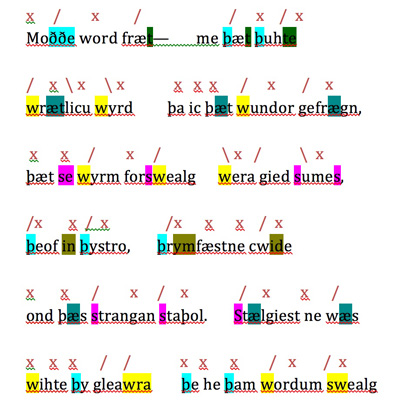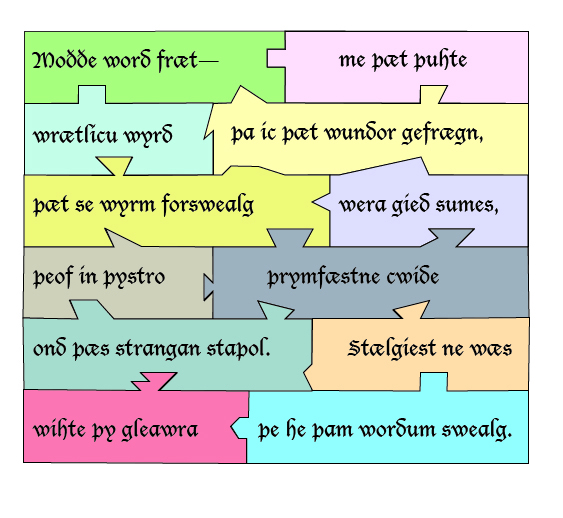
For my final project in Peter Baker’s Old English course, I wanted to explore how the form of a puzzle could be applied to a different style of poetry in a different language (vs. the sonnets that the Puzzle Poesis group had been making). My goal was to create a visual representation of alliterative Anglo-Saxon verse, to emphasize the patterns of alliteration, meter, and lifts in a tangible way. In doing so, I also sought to learn more about Old English versification by engaging in higher-level thinking about my project (according to Bloom’s taxonomy) and by creating a puzzle that could be used as a pedagogical tool to encourage others to do the same.
Before I attempted to create a three-dimensional model, I marked up a version of the “Bookworm Riddle” (Riddle 45), using the didactic tutorials from Baker’s Introduction to Old English “Chapter 13: Metre.” I also listened to two recordings of the poem in Old English (e.g. on Swarthmore’s website) to hear the lifts and drops. The most common alliterations were of the “w” and thorn sounds. The pattern of those alliterations works as an interline lock, uniting the entire poem, just as the individual alliterations serve as intraline glue, linking both half-lines together. There is one line with a thorn alliteration at the beginning and two at the end, while there are two lines with a “w” alliteration at the beginning and only one at the end. Thus, there is a macro-chiasmic structure to the thorn and “w” alliterations throughout the poem. The final line uses both the thorn and “w” alliterative patterns, while the sounds of the ash and the “s” alternate in the middle of the poem:

In translation:
A bug ate words—to me, that seemed
a fate like a jewel when I learned about that wonder,
that the worm consumed the word of a certain one of men,
a thief in the dark, a glory-bound text
and its strong foundation. The thief-guest was none
the wiser, for having swallowed those words.
Mocked up in Illustrator:

In this first version, each half-line is a different color, and the puzzle piece breaks are on the caesura. The breaking of the verse would be paralleled by a literal break in the pieces. Another version of this poem could make each line its own color (instead of each verse).